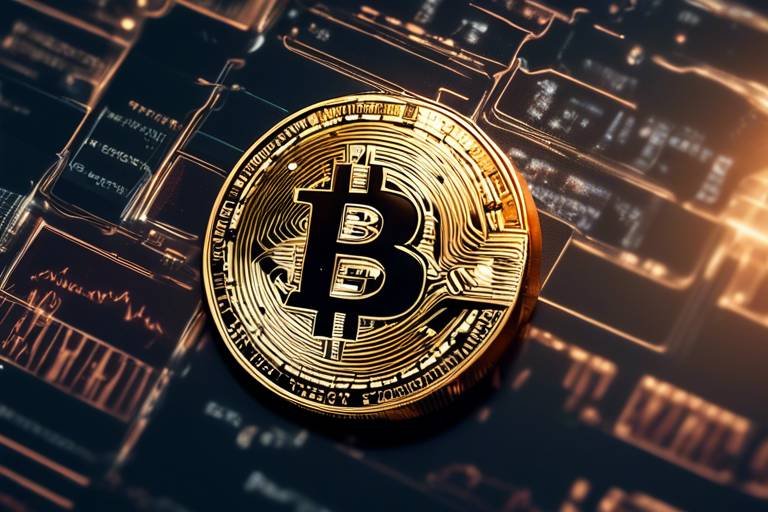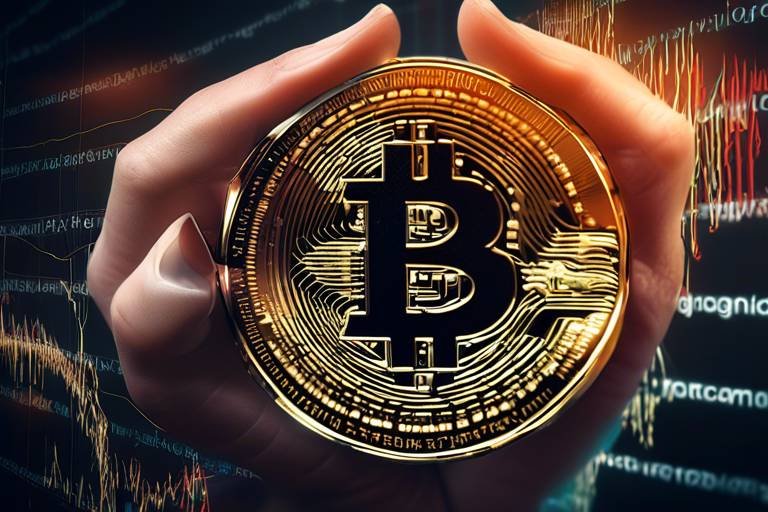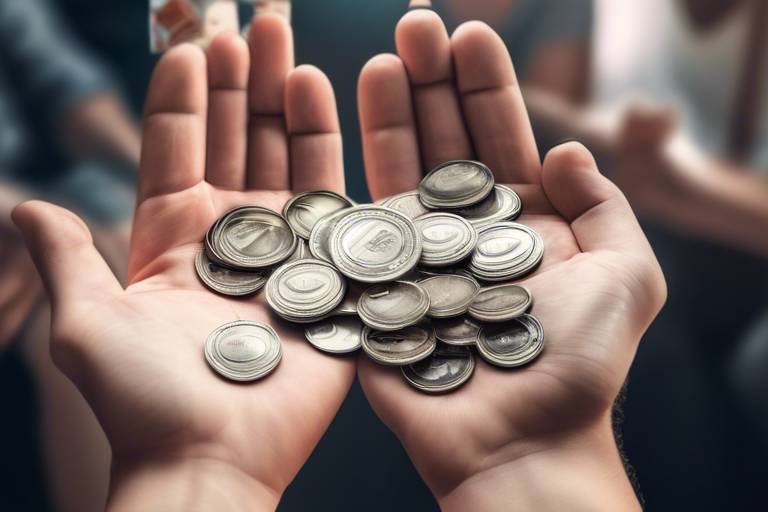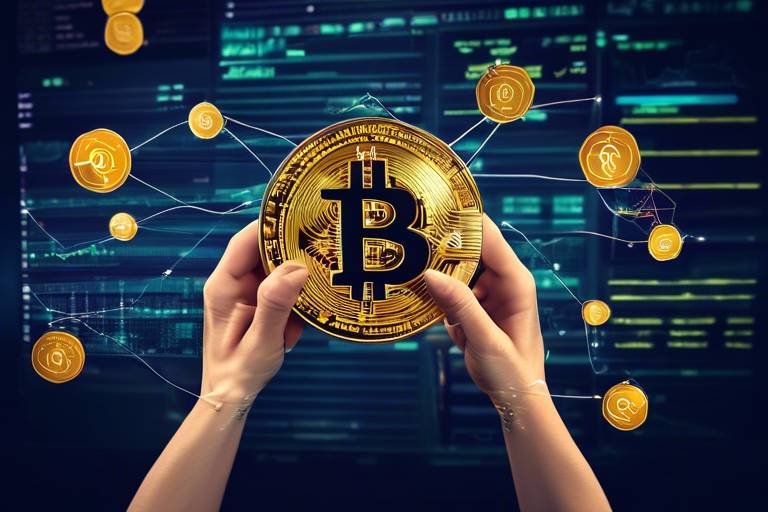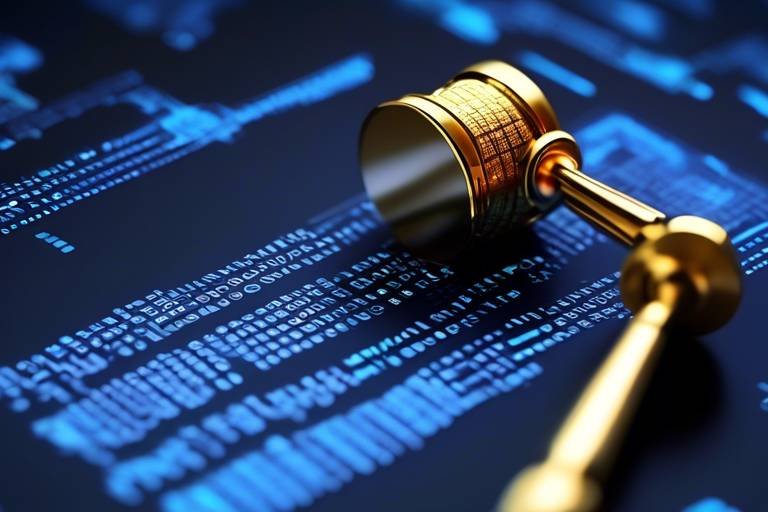The Role of Blockchain in Protecting Human Rights
This article explores how blockchain technology can enhance human rights protection by ensuring transparency, accountability, and security in various sectors, including governance, finance, and personal data management. In a world where human rights violations persist, blockchain offers a glimmer of hope. Imagine a world where every transaction is recorded in a way that cannot be altered or erased. This is the essence of blockchain—a decentralized digital ledger that has the potential to revolutionize how we protect the rights of individuals.
At its core, blockchain is a decentralized digital ledger that records transactions across multiple computers. This technology ensures data integrity and security, making it a powerful tool for safeguarding human rights in various applications. Think of it as a digital notebook that everyone can see but no one can change. Each page in this notebook is a block, and once a page is filled, it is sealed off and linked to the previous one, creating a chain of information. This structure not only prevents tampering but also enhances trust among users.
One of the most significant advantages of blockchain is its ability to facilitate transparent monitoring of human rights abuses. By providing an immutable record of events, blockchain empowers activists and organizations to hold perpetrators accountable. Imagine a scenario where evidence of human rights violations—like unlawful detentions or police brutality—can be documented and verified in real-time. This transparency can be a game-changer, allowing victims to reclaim their narratives and seek justice.
Examining real-world examples where blockchain has been implemented to protect human rights provides valuable insights into its effectiveness and potential for broader application. For instance, in regions plagued by corruption, blockchain has been used to ensure that humanitarian aid reaches those in need without being siphoned off by middlemen. The transparency of blockchain allows donors to track their contributions, ensuring that every dollar is accounted for.
Blockchain enhances supply chain transparency, allowing consumers to verify the ethical sourcing of products and ensuring that labor rights are respected throughout the production process. This is particularly crucial in industries like fashion and electronics, where exploitative labor practices can be rampant. With blockchain, consumers can scan a QR code on a product and see its entire journey—from raw materials to the store shelf—ensuring that they are making ethical choices.
Using blockchain for identity verification can help marginalized communities gain access to essential services, protecting their rights and reducing the risk of identity theft and fraud. In many parts of the world, people lack formal identification, which can prevent them from accessing healthcare, education, and employment opportunities. Blockchain can create a secure, verifiable identity that individuals control, empowering them to participate fully in society.
Despite its potential, blockchain technology faces challenges, including scalability, energy consumption, and regulatory hurdles that could impede its effectiveness in protecting human rights. For example, the energy required to maintain blockchain networks can be significant, raising concerns about sustainability. Additionally, regulatory frameworks are still evolving, and navigating these can be complex for organizations looking to implement blockchain solutions.
Decentralization is a core principle of blockchain that can empower individuals by giving them control over their personal data and reducing reliance on centralized authorities that may violate rights. In a world where data breaches and privacy violations are rampant, blockchain offers a way for individuals to reclaim their data ownership and ensure that their information is secure.
Community-led blockchain initiatives showcase how local groups are leveraging technology to advocate for human rights, demonstrating grassroots efforts to address systemic issues. For instance, in countries with oppressive regimes, activists are using blockchain to document human rights abuses, providing a safe space for whistleblowers to share information without fear of retaliation. These initiatives not only highlight the power of technology but also the resilience of communities fighting for their rights.
The future of blockchain in the realm of human rights looks promising, with ongoing innovations and collaborations aimed at enhancing its applications and effectiveness in safeguarding freedoms globally. As more organizations recognize the potential of blockchain, we can expect to see a surge in projects aimed at protecting vulnerable populations and promoting justice. The key will be to address the challenges head-on and create a framework that supports ethical blockchain development.
- What is blockchain technology? Blockchain is a decentralized digital ledger that records transactions across multiple computers, ensuring data integrity and security.
- How does blockchain help in monitoring human rights? It provides an immutable record of events, empowering activists to hold perpetrators accountable.
- What are some challenges of blockchain technology? Challenges include scalability, energy consumption, and regulatory hurdles.
- Can blockchain protect identity? Yes, blockchain can create secure, verifiable identities for marginalized communities.

Understanding Blockchain Technology
Blockchain is a revolutionary technology that has captured the attention of industries worldwide. At its core, it is a decentralized digital ledger that records transactions across multiple computers in a way that ensures data integrity and security. Imagine a book where every page is a record of a transaction, and once a page is filled, it cannot be altered or erased. This concept of immutability is what makes blockchain a powerful tool in safeguarding human rights.
The decentralized nature of blockchain means that no single entity has control over the entire database. Instead, every participant in the network has access to the same information, which significantly reduces the risk of fraud and manipulation. This characteristic is particularly important in contexts where transparency and accountability are crucial, such as in governance, finance, and personal data management. In essence, blockchain acts as a digital fortress, protecting sensitive information from unauthorized access and ensuring that it remains untampered.
One of the most appealing aspects of blockchain technology is its ability to enhance transparency. When data is recorded on the blockchain, it becomes part of a public ledger that anyone can access. This level of transparency can be a game-changer in monitoring human rights abuses. For instance, if a government or organization attempts to cover up an incident, the immutable record on the blockchain can serve as undeniable evidence, empowering activists and organizations to hold perpetrators accountable.
Furthermore, blockchain can facilitate secure transactions without the need for intermediaries. This means that individuals can engage in financial transactions or share personal data without relying on centralized authorities, which may not always have their best interests at heart. In a world where privacy breaches are rampant, blockchain provides a safeguard against identity theft and fraud, allowing people to maintain control over their own information.
To illustrate the potential of blockchain in human rights protection, consider the following applications:
- Supply Chain Transparency: Blockchain can track the origin of products, ensuring that they are ethically sourced and that labor rights are respected.
- Identity Verification: It can help marginalized communities gain access to essential services by providing a secure and verifiable identity.
- Voting Systems: Blockchain can enhance the integrity of electoral processes, ensuring that every vote is counted and recorded accurately.
Each of these applications demonstrates how blockchain can be harnessed to protect and promote human rights in various sectors. However, it is essential to recognize that while blockchain technology offers significant advantages, it is not a silver bullet. The challenges and limitations of blockchain will be explored in the following sections, but for now, it's clear that understanding this technology is the first step toward leveraging its potential for human rights protection.

Transparency in Human Rights Monitoring
In an age where information flows like a river, the need for transparency in monitoring human rights has never been more critical. Blockchain technology rises to the occasion, acting as a beacon of hope for activists and organizations striving to hold violators accountable. Imagine a world where every action taken against human rights can be traced back to its origin, where the truth is not just a fleeting whisper but a loud, clear shout. This is the promise that blockchain holds.
At its core, blockchain provides an immutable record of events. This means that once information is recorded on the blockchain, it cannot be altered or deleted. Such a feature is revolutionary in the realm of human rights, as it ensures that evidence of abuses—be it torture, unlawful detentions, or discrimination—remains intact and accessible. Activists can document incidents in real-time, creating a comprehensive and trustworthy archive that can be referred to in legal proceedings or advocacy efforts.
Consider a scenario where a human rights organization is monitoring a conflict zone. With blockchain, they can log incidents of violence or abuse as they occur, attaching timestamps and GPS coordinates. This data can be shared with the global community, ensuring that the world knows what is happening, thereby increasing pressure on perpetrators. The transparency offered by blockchain can empower communities, enabling them to stand up against injustice with concrete evidence.
Moreover, the use of blockchain can foster collaboration among various stakeholders. Organizations can work together on a shared platform, contributing data and insights while maintaining the integrity of the information. This collaborative approach can lead to a more comprehensive understanding of human rights violations and help in formulating effective responses. For instance, the following stakeholders can benefit:
- NGOs: Non-governmental organizations can utilize blockchain to document abuses and advocate for policy changes.
- Governments: Transparent records can assist governments in identifying and addressing human rights issues.
- International Bodies: Organizations like the UN can leverage blockchain data for reports and interventions.
However, while the benefits are clear, there are challenges to consider. The technology's accessibility is paramount; not everyone has the knowledge or resources to utilize blockchain effectively. Training and education are essential to ensure that those on the front lines of human rights advocacy can leverage this tool to its fullest potential. Additionally, the digital divide can create disparities in how different communities access and use blockchain technology.
In conclusion, the transparency provided by blockchain technology is a game-changer in the monitoring of human rights abuses. It not only creates a secure and verifiable record of events but also empowers individuals and organizations to take action. As we move forward, the integration of blockchain into human rights monitoring can pave the way for a more just and accountable world.
1. How does blockchain ensure data integrity?
Blockchain ensures data integrity through its decentralized nature, where each transaction is recorded across multiple nodes, making it virtually impossible to alter past records without consensus.
2. Can blockchain be used to monitor human rights in real-time?
Yes, blockchain can be used to log incidents as they happen, providing a real-time account of human rights violations that can be referenced later.
3. What are the challenges of using blockchain for human rights monitoring?
Challenges include accessibility, the need for training, and the digital divide that may prevent some communities from effectively using the technology.

Case Studies of Blockchain in Action
When it comes to understanding the true potential of blockchain technology in protecting human rights, real-world examples speak volumes. Let's dive into some compelling case studies that illustrate how blockchain is not just a buzzword, but a transformative force in the fight for justice and accountability. One noteworthy example is the use of blockchain in the land registration process in countries like Georgia. By utilizing a blockchain-based system, the government has significantly reduced instances of land disputes and fraud. This initiative has empowered citizens by providing them with an immutable record of their land ownership, thereby protecting their property rights.
Another fascinating case is the BitPesa platform, which leverages blockchain to facilitate cross-border payments in Africa. This service not only enhances financial inclusion but also ensures that individuals, especially in marginalized communities, can access their funds securely and transparently. By reducing transaction costs and providing a reliable payment system, BitPesa helps protect the economic rights of its users.
In the realm of humanitarian aid, the World Food Programme (WFP) has implemented a blockchain solution called Building Blocks to deliver food assistance. By using blockchain, the WFP can verify transactions and ensure that aid reaches the intended recipients without the risk of fraud. This initiative not only enhances accountability but also restores dignity to those receiving aid, ensuring that their rights are respected and upheld.
Furthermore, the Everledger project is revolutionizing the diamond industry by creating a digital ledger for tracking the provenance of diamonds. This initiative helps combat conflict diamonds, ensuring that consumers are aware of the ethical sourcing of their purchases. By providing transparency in the supply chain, Everledger empowers consumers to make informed choices, protecting the rights of workers and communities involved in diamond mining.
These case studies illustrate the diverse applications of blockchain technology in safeguarding human rights. From land ownership to financial transactions and humanitarian aid, blockchain proves to be a versatile tool that enhances transparency and accountability. However, the journey doesn’t stop here. As we explore further, it’s essential to address the challenges and limitations that come with implementing blockchain solutions.
- What is blockchain technology? Blockchain is a decentralized digital ledger that records transactions across multiple computers, ensuring data integrity and security.
- How does blockchain enhance human rights protection? By providing transparency, accountability, and security in various sectors, blockchain can help monitor and prevent human rights abuses.
- What are some real-world applications of blockchain in human rights? Examples include land registration, financial services, humanitarian aid distribution, and supply chain transparency.
- What challenges does blockchain face in human rights applications? Challenges include scalability, energy consumption, regulatory hurdles, and the need for widespread adoption.

Blockchain in Supply Chain Management
Blockchain technology is revolutionizing the way we think about supply chains, and its impact on human rights is nothing short of remarkable. Imagine a world where you can trace the journey of your favorite product from the moment it’s sourced to when it reaches your hands. This is not just a dream; it’s a reality made possible by blockchain. By providing a transparent and immutable record of transactions, blockchain allows consumers to verify the ethical sourcing of products, ensuring that labor rights are respected throughout the production process.
Consider this: every time you buy a piece of clothing, you might wonder about the conditions under which it was made. Were the workers treated fairly? Were they paid a living wage? With blockchain, you can answer these questions confidently. Each step of the supply chain can be recorded on a decentralized ledger, making it accessible to everyone involved—from manufacturers to consumers. This level of transparency not only empowers consumers but also holds companies accountable for their practices. If a company is found to be exploiting labor, the information is readily available, allowing consumers to make informed decisions.
Moreover, blockchain can help combat issues like child labor and forced labor. By providing a secure and transparent method for tracking the origins of products, companies can ensure that their supply chains are free from human rights abuses. A recent study showed that companies implementing blockchain in their supply chains experienced a significant decrease in the number of reported human rights violations. This is a game-changer for industries that have historically struggled with accountability.
To illustrate the effectiveness of blockchain in supply chain management, consider the following table that highlights key benefits:
| Benefit | Description |
|---|---|
| Transparency | All transactions are recorded and visible, allowing for easy tracking of product origins. |
| Accountability | Companies can be held responsible for unethical practices, fostering a culture of responsibility. |
| Consumer Trust | Increased transparency leads to higher consumer confidence in product sourcing. |
| Reduction of Fraud | Immutable records help prevent counterfeit products from entering the market. |
In conclusion, blockchain in supply chain management is not just about improving efficiency; it’s about creating a fairer world. By ensuring that products are sourced ethically and that workers' rights are protected, blockchain is paving the way for a new era of corporate responsibility. As consumers, we have the power to demand transparency, and blockchain gives us the tools to do just that. So, the next time you make a purchase, remember that you can play a part in supporting human rights through the choices you make.
- What is blockchain technology? Blockchain is a decentralized digital ledger that records transactions across multiple computers, ensuring data integrity and security.
- How does blockchain promote human rights? By providing transparency and accountability in various sectors, blockchain helps to protect individuals' rights and prevent abuses.
- Can blockchain be used in all industries? While blockchain has broad applications, its effectiveness can vary by industry, particularly in those with complex supply chains.
- What are the challenges of implementing blockchain? Scalability, energy consumption, and regulatory hurdles are some of the challenges that can impede blockchain's effectiveness.

Blockchain for Identity Verification
In a world where identity theft and fraud are rampant, the need for secure and reliable identity verification methods has never been more critical. Enter blockchain technology, a game-changer in the realm of personal identification. By leveraging the unique features of blockchain, individuals—especially those from marginalized communities—can gain access to essential services while safeguarding their rights.
Imagine a system where your identity is not just a number or a card but a unique digital fingerprint stored securely on a decentralized network. This is precisely what blockchain offers. Unlike traditional identity verification methods that rely on centralized databases, which are vulnerable to breaches and unauthorized access, blockchain provides a tamper-proof solution. Each transaction or identity verification is recorded on a public ledger that is immutable and transparent, ensuring that once your identity is verified, it cannot be altered or erased without consensus from the network.
One of the most significant advantages of using blockchain for identity verification is its ability to empower individuals. With blockchain, users have full control over their personal data, allowing them to share only what is necessary with service providers. This data sovereignty reduces the risk of exploitation by centralized authorities and minimizes the chances of identity theft. For example, instead of carrying multiple forms of identification, individuals can use a single blockchain-based identity that is universally accepted across various platforms.
Furthermore, blockchain technology can be particularly beneficial for refugees and stateless individuals who often lack formal identification documents. By creating a secure digital identity on the blockchain, these individuals can access crucial services such as healthcare, education, and banking, which are often denied to them due to their undocumented status. This not only enhances their quality of life but also upholds their fundamental human rights.
However, it’s essential to recognize that while blockchain offers revolutionary potential for identity verification, it is not without its challenges. Issues such as scalability, energy consumption, and the need for regulatory frameworks must be addressed to ensure widespread adoption. Moreover, educating communities about how to use this technology safely and effectively is crucial. Only then can we fully harness the power of blockchain to create a more inclusive and secure future for identity verification.
In summary, blockchain technology is paving the way for a new era of identity verification that prioritizes security, privacy, and empowerment. By providing individuals with control over their personal data and offering a reliable means of verification, blockchain is not just a technological innovation; it is a vital tool in the fight for human rights.
- What is blockchain technology? Blockchain is a decentralized digital ledger that securely records transactions across multiple computers, ensuring data integrity and security.
- How does blockchain enhance identity verification? Blockchain creates a secure, tamper-proof digital identity that individuals control, reducing the risk of identity theft and fraud.
- Can blockchain help marginalized communities? Yes, blockchain can provide secure digital identities for marginalized groups, enabling access to essential services they may otherwise be denied.
- What challenges does blockchain face in identity verification? Challenges include scalability, energy consumption, and the need for regulatory frameworks to support widespread adoption.

Challenges and Limitations of Blockchain
While blockchain technology holds immense potential for protecting human rights, it is not without its challenges and limitations. One of the primary concerns is scalability. As more users join the network and transactions increase, the blockchain can become congested, leading to slower processing times. This is particularly problematic when immediate action is required to address human rights violations. Imagine trying to get help during a crisis, only to find that the system is too slow to respond!
Another significant issue is energy consumption. Many blockchain networks, especially those that use a proof-of-work consensus mechanism, require substantial computational power, which translates to high energy usage. This not only raises environmental concerns but also questions the sustainability of implementing blockchain solutions on a larger scale. The irony is that while blockchain aims to promote transparency and accountability, its environmental footprint could undermine its very goals.
Additionally, regulatory hurdles pose a challenge for the widespread adoption of blockchain technology. Governments around the world are still grappling with how to regulate this decentralized technology. Without clear regulations, organizations may hesitate to invest in blockchain solutions for fear of legal repercussions. This uncertainty can stifle innovation and prevent the technology from being fully utilized in the fight for human rights.
Moreover, there are concerns regarding data privacy. While blockchain is known for its transparency, this very feature can lead to potential risks. Sensitive information, if not properly encrypted, could be exposed on the blockchain, putting individuals at risk. Striking a balance between transparency and privacy is crucial, especially when dealing with vulnerable populations whose rights need protection.
Lastly, the digital divide cannot be overlooked. Not everyone has equal access to technology or the internet, which means that marginalized communities might be left out of the benefits that blockchain can offer. If we want to leverage blockchain for human rights, we must also ensure that everyone has the means to participate in this digital revolution.
In summary, while blockchain presents exciting opportunities for enhancing human rights protection, it is essential to address these challenges head-on. By doing so, we can unlock the full potential of this technology and ensure that it serves as a powerful ally in the fight for justice and equality.
- What is blockchain technology?
Blockchain is a decentralized digital ledger that records transactions across multiple computers, ensuring data integrity and security.
- How can blockchain help in protecting human rights?
Blockchain can enhance transparency and accountability, allowing for better monitoring of human rights abuses and empowering activists.
- What are the main challenges of blockchain?
Challenges include scalability, energy consumption, regulatory hurdles, data privacy concerns, and the digital divide.
- Can blockchain be used for identity verification?
Yes, blockchain can provide secure identity verification, helping marginalized communities access essential services and protecting their rights.

Decentralization and Empowerment
Decentralization is one of the most revolutionary aspects of blockchain technology, and it holds immense potential for empowering individuals and communities. Imagine a world where your personal data isn't controlled by a handful of corporations but rather by you. This shift from centralized control to a decentralized model is akin to handing over the keys to your own castle, allowing you to decide who enters and who stays out. With blockchain, individuals can take charge of their own identities, transactions, and interactions without the fear of exploitation or misuse by centralized authorities.
In many parts of the world, centralized systems have often led to human rights abuses, whether through data breaches, surveillance, or outright denial of services. By decentralizing control, blockchain technology can significantly reduce these risks. For instance, individuals can manage their own identity verification processes without needing to rely on government-issued IDs or corporate entities that may not have their best interests at heart. This is especially crucial for marginalized communities who often face systemic barriers in accessing essential services.
Furthermore, the empowerment that comes from decentralization fosters a sense of community and collaboration. Local groups can use blockchain to create their own networks, enabling them to share resources, information, and support without the interference of external powers. This kind of grassroots movement can lead to more equitable solutions to human rights issues, as community members are often more attuned to the specific needs and challenges faced by their peers.
To illustrate the impact of decentralization in empowering communities, consider the following examples:
| Initiative | Description | Impact |
|---|---|---|
| Uphold | A blockchain-based platform for identity verification. | Helps individuals in developing countries access banking services. |
| Everledger | Blockchain for tracking the provenance of diamonds. | Ensures ethical sourcing and combats conflict diamonds. |
| BitPesa | A blockchain payment platform for African businesses. | Facilitates cross-border transactions and financial inclusion. |
These initiatives not only highlight the potential of decentralization but also demonstrate how blockchain can serve as a catalyst for social change. By empowering individuals and communities, we can create a more just and equitable society where human rights are respected and upheld.
As we look to the future, it's essential to recognize that the journey toward empowerment through decentralization is ongoing. The more we adopt and adapt blockchain technology, the more we can ensure that it serves as a tool for liberation rather than oppression. The road may be long, but the potential rewards are immense—an empowered populace, a more transparent world, and a significant step toward safeguarding human rights for everyone.
- What is decentralization in blockchain? Decentralization refers to the distribution of control and decision-making away from a central authority, allowing individuals to manage their own data and identities.
- How does blockchain empower marginalized communities? By providing secure and self-managed identity verification, blockchain allows marginalized groups to access essential services without relying on potentially exploitative centralized systems.
- What are some challenges of decentralization? While decentralization has many benefits, challenges include the need for user education, potential for misuse, and the technical barriers to accessing blockchain technology.

Community-Led Initiatives
Community-led initiatives are like the beating heart of the blockchain movement, showcasing how local groups can harness this revolutionary technology to advocate for human rights. Imagine a small village in a developing country, where access to information and resources is limited. Here, blockchain becomes a beacon of hope. By empowering individuals to take control of their own data, these initiatives help marginalized communities assert their rights and demand accountability from those in power.
One remarkable example is the use of blockchain in land registration. In many parts of the world, land ownership is often a source of conflict, particularly for indigenous communities. Traditional systems can be corrupt or inefficient, leaving many without legal recognition of their property. However, blockchain’s immutable ledger can provide a transparent and secure method for recording land ownership. This not only protects the rights of individuals but also helps to prevent land grabs and disputes, ensuring that communities can maintain their livelihoods and cultural heritage.
Moreover, community-led blockchain projects often focus on providing essential services that are otherwise inaccessible. For instance, several initiatives have emerged to create decentralized identity systems. These systems allow individuals, especially those in vulnerable situations, to establish their identity without relying on centralized authorities that may overlook or actively violate their rights. By enabling self-sovereign identities, communities can access healthcare, education, and financial services, thus fostering a sense of dignity and empowerment.
Additionally, many of these grassroots initiatives are supported by non-profit organizations and tech-savvy volunteers who believe in the potential of blockchain to drive social change. They work tirelessly to educate communities about how to leverage this technology effectively. Workshops, hackathons, and seminars are organized to help locals understand blockchain's benefits and applications. This is crucial because the more informed a community is, the better equipped they are to advocate for their rights and challenge injustices.
To illustrate the impact of these initiatives, consider the following table that highlights some notable community-led blockchain projects around the globe:
| Project Name | Location | Focus Area | Description |
|---|---|---|---|
| Land Registry Blockchain | Colombia | Land Rights | A project aimed at securing land titles for indigenous communities using blockchain technology. |
| Everledger | Global | Asset Tracking | A blockchain platform that tracks the provenance of diamonds to prevent conflict financing. |
| Self-sovereign Identity | Various | Identity Verification | Initiatives that provide individuals with control over their personal data and identity. |
In conclusion, community-led initiatives are vital for demonstrating the practical applications of blockchain technology in the fight for human rights. They not only empower individuals but also foster a sense of community and collective action. As these projects continue to grow and evolve, they hold the promise of creating a more just and equitable world, where everyone's rights are respected and upheld.
- What are community-led blockchain initiatives?
These are grassroots projects that utilize blockchain technology to promote human rights and empower local communities. - How does blockchain help in land registration?
Blockchain provides a secure and transparent way to record land ownership, reducing the risk of disputes and corruption. - What is self-sovereign identity?
This concept allows individuals to manage their own identity without relying on centralized authorities, enhancing privacy and security. - Why are these initiatives important?
They empower marginalized communities, promote transparency, and advocate for accountability in human rights protection.

Future Prospects for Blockchain and Human Rights
The future of blockchain technology in the realm of human rights is not just bright; it’s positively glowing with potential. As we look ahead, it’s clear that this revolutionary technology can play a pivotal role in transforming how we protect and promote human rights globally. With ongoing innovations and collaborative efforts, blockchain is set to redefine the landscape of accountability and transparency.
Imagine a world where every transaction related to human rights is recorded on a public ledger that cannot be altered or deleted. This level of transparency could deter potential violators, knowing that their actions are permanently documented. Furthermore, blockchain's decentralized nature empowers individuals by giving them control over their own data. This could lead to a significant shift in how personal information is managed, reducing the risks associated with data breaches and identity theft.
Moreover, the integration of blockchain with emerging technologies like artificial intelligence (AI) and the Internet of Things (IoT) could create even more robust systems for monitoring human rights abuses. For example, AI could analyze blockchain data to detect patterns of abuse, while IoT devices could provide real-time data on conditions in vulnerable areas. Together, these technologies could form a comprehensive ecosystem for human rights advocacy.
However, it’s essential to acknowledge that the journey ahead is not without its challenges. As blockchain technology continues to evolve, issues such as scalability and energy consumption must be addressed. These challenges could hinder the widespread adoption of blockchain in human rights applications. Additionally, regulatory frameworks are still catching up with the rapid pace of technological advancement. It’s crucial for stakeholders—governments, NGOs, and tech companies—to collaborate and develop policies that support the ethical use of blockchain.
In terms of grassroots movements, community-led initiatives are already showcasing the power of blockchain in advocating for human rights. Local organizations are leveraging this technology to create solutions tailored to their specific challenges. For instance, in regions where traditional identity documentation is lacking, blockchain can provide a secure and verifiable method for identity verification, enabling individuals to access essential services.
As we move forward, the potential for blockchain to safeguard freedoms is immense. Ongoing research and development will likely yield new applications that can address current limitations. The collaboration between tech innovators, human rights advocates, and policymakers will be crucial in harnessing the full potential of blockchain technology. With collective effort and vision, we can create a future where human rights are not just upheld but are actively protected by cutting-edge technology.
- What is blockchain technology?
Blockchain is a decentralized digital ledger that records transactions across multiple computers, ensuring data integrity and security.
- How can blockchain enhance human rights protection?
Blockchain enhances human rights protection by providing transparency, accountability, and security in various sectors, making it easier to monitor abuses.
- What are some challenges facing blockchain in human rights?
Challenges include scalability, energy consumption, and regulatory hurdles that could impede its effectiveness.
- What role do community-led initiatives play?
Community-led initiatives demonstrate how local groups can leverage blockchain technology to advocate for human rights and address systemic issues.
Frequently Asked Questions
- What is blockchain technology?
Blockchain technology is a decentralized digital ledger that securely records transactions across multiple computers. This ensures data integrity and security, making it an essential tool for protecting human rights in various sectors.
- How does blockchain enhance transparency in human rights monitoring?
Blockchain provides an immutable record of events, allowing for transparent monitoring of human rights abuses. This transparency empowers activists and organizations to hold perpetrators accountable, ensuring that violations are documented and addressed.
- Can you provide examples of blockchain being used to protect human rights?
Absolutely! There are several case studies where blockchain has been effectively implemented. For instance, in supply chain management, blockchain allows consumers to verify ethical sourcing, ensuring labor rights are respected. Additionally, blockchain can aid in identity verification for marginalized communities, helping them access essential services and reducing identity theft risks.
- What challenges does blockchain face in human rights protection?
Despite its potential, blockchain technology encounters several challenges, including scalability issues, high energy consumption, and regulatory hurdles. These factors can impede its effectiveness in safeguarding human rights on a larger scale.
- How does decentralization empower individuals?
Decentralization is a fundamental principle of blockchain that allows individuals to have control over their personal data. By reducing reliance on centralized authorities, which may violate rights, blockchain empowers people to manage their information securely.
- What are community-led blockchain initiatives?
Community-led blockchain initiatives are grassroots efforts where local groups leverage blockchain technology to advocate for human rights. These initiatives showcase how communities can address systemic issues and promote accountability through innovative solutions.
- What does the future hold for blockchain and human rights?
The future of blockchain in the realm of human rights appears promising. With ongoing innovations and collaborations, there are many opportunities to enhance its applications and effectiveness in safeguarding freedoms globally.






